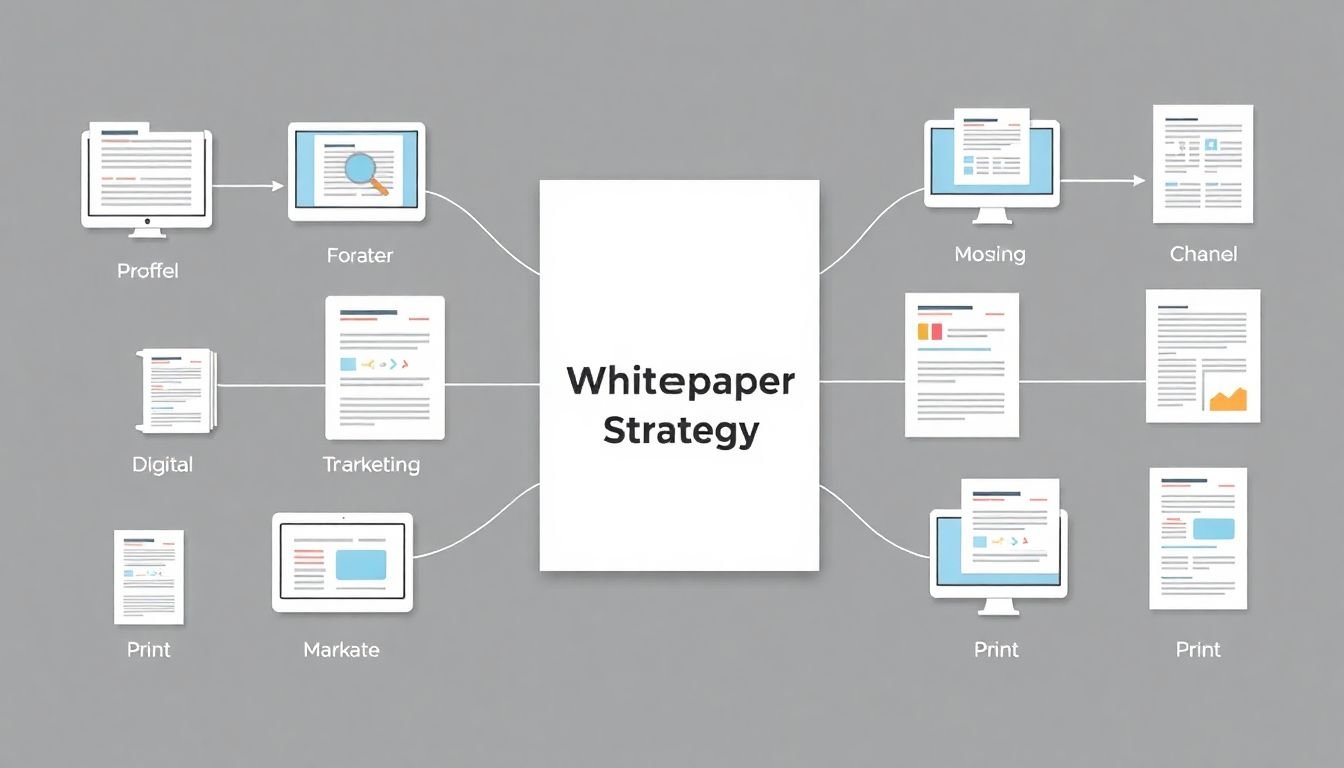
Table of Contents
In the dynamic world of digital marketing, creating a comprehensive whitepaper is no small feat. It’s a testament to your team’s expertise, a reflection of your brand’s thought leadership, and a powerful tool for generating leads and driving engagement. But what happens after the whitepaper is published? Does it gather dust in a digital corner, or does it continue to work for you, fueling your multi-channel marketing strategy? Today, we’re diving into the art of content repurposing, exploring how to maximize the potential of your whitepaper across multiple channels. Let’s agree that creating a whitepaper is just the beginning, promise that by the end of this article, you’ll have a robust strategy to repurpose your content, and preview the exciting journey ahead.
Did you know that according to DemandMetric, content marketing costs 62% less than traditional marketing and generates about 3 times as many leads? Yet, many businesses struggle to maintain a consistent content flow, with 60% of marketers struggling to produce content consistently, as reported by Content Marketing Institute. The challenge lies not in creating content, but in repurposing it effectively. Imagine if every piece of content you create could work as hard as your whitepaper did to get published
- that’s the power of multi-channel content repurposing.
Let’s start with a compelling question: What if your whitepaper could continue to generate leads, build your brand, and engage your audience long after its initial publication? What if it could reach not just your website visitors, but also your social media followers, email subscribers, and podcast listeners? That’s not just a dream; it’s a reality with a well-planned content repurposing strategy. In this article, we’ll explore how to transform your whitepaper into a multi-channel marketing powerhouse. We’ll delve into the why, what, and how of repurposing, providing real-life examples and actionable tips to help you make the most of your content.
So, are you ready to unlock the full potential of your whitepaper? Let’s embark on this journey together. By the end of this article, you’ll have a clear understanding of how to repurpose your content across multiple channels, ensuring that your whitepaper continues to work for you, driving results and growing your business. Let’s dive in!
Maximizing Your Whitepaper’s Reach: A Multi-Channel Content Repurposing Strategy
In the dynamic landscape of today’s digital world, a well-crafted whitepaper can be a powerful tool for businesses to educate, engage, and attract their target audience. However, creating a whitepaper is just the first step. To truly maximize its reach and impact, a multi-channel content repurposing strategy is key. This approach involves transforming your whitepaper into a variety of engaging formats that can be shared across multiple platforms, reaching a wider audience and extending the lifespan of your content. By breaking down your whitepaper into bite-sized blog posts, infographics, videos, podcasts, and social media snippets, you can cater to different learning styles and preferences, making your content more accessible and appealing. Moreover, this strategy helps to build a strong content ecosystem, where each piece supports and reinforces the others, driving traffic back to your original whitepaper and ultimately, your brand. So, let’s dive into the world of content repurposing and explore how you can maximize your whitepaper’s reach, one channel at a time.
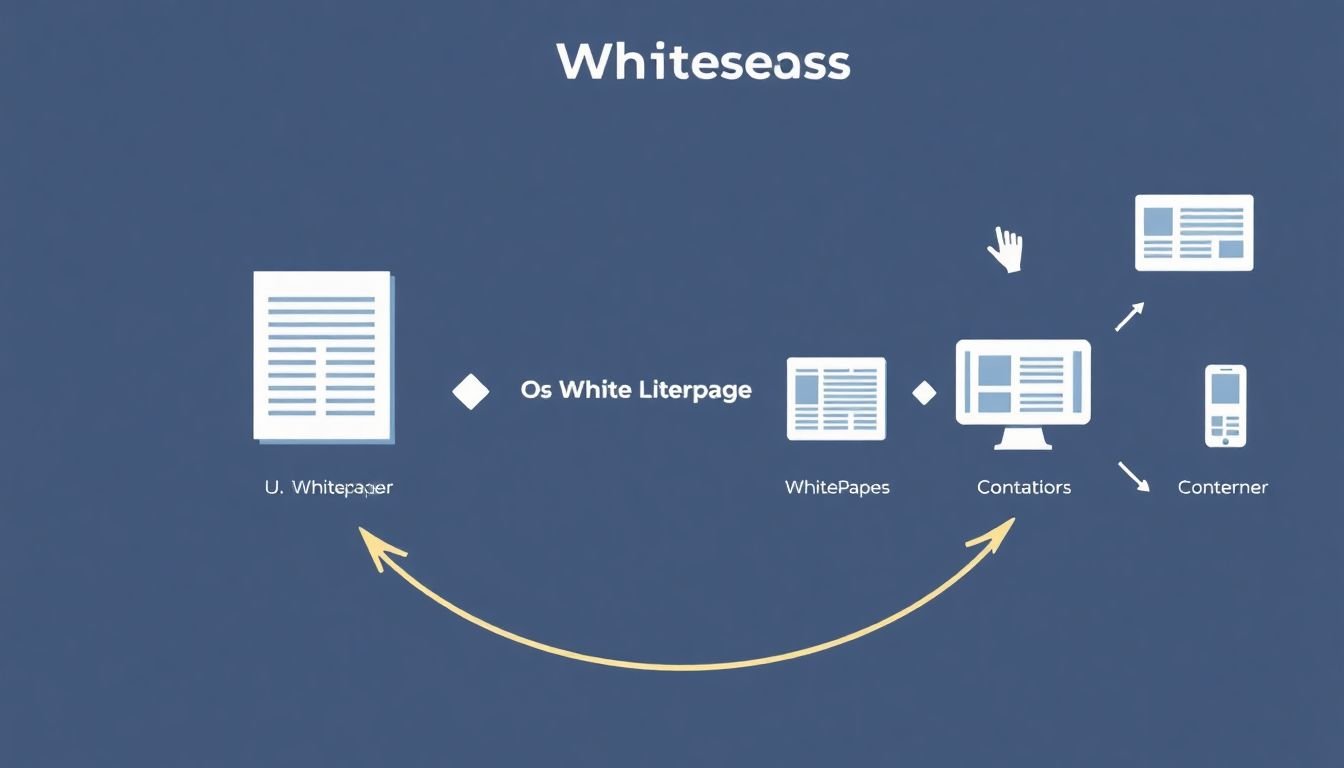
The Power of Repurposing: Why Your Whitepaper Deserves a Second Life
In the dynamic world of content marketing, creating a comprehensive whitepaper is no small feat. It requires extensive research, meticulous writing, and expert design. However, once published, many whitepapers are left to gather digital dust, their valuable insights and expertise forgotten. This is where the power of repurposing comes into play. Repurposing your whitepaper isn’t just about giving old content a facelift; it’s about extending its lifespan, amplifying its reach, and maximizing its impact.
Firstly, repurposing saves time and resources. Creating a whitepaper from scratch is a significant investment. By repurposing, you’re leveraging the work you’ve already done. Instead of starting from square one, you’re building upon an existing foundation. This allows you to reach new audiences with minimal additional effort.
Secondly, repurposing extends the reach of your whitepaper. Different formats appeal to different audiences. While some prefer in-depth, long-form content, others prefer bite-sized, easily digestible pieces. By repurposing your whitepaper into blog posts, infographics, videos, or podcasts, you’re catering to a wider range of preferences, increasing the likelihood of your content being seen and shared.
Lastly, repurposing helps establish thought leadership. By consistently providing valuable, insightful content, you position yourself as an authority in your field. Repurposing allows you to do this more frequently and with less effort. For instance, you could turn a whitepaper on ‘The Future of AI’ into a series of blog posts, each focusing on a different aspect, or a webinar, or even a Twitter thread. Each format reaches a new audience, reinforcing your expertise and influence.
In conclusion, repurposing isn’t just a smart strategy; it’s a necessity in today’s content-saturated world. It’s about making the most of what you’ve already created, extending the life of your content, and maximizing its impact. So, don’t let your whitepaper gather dust. Give it a second life!
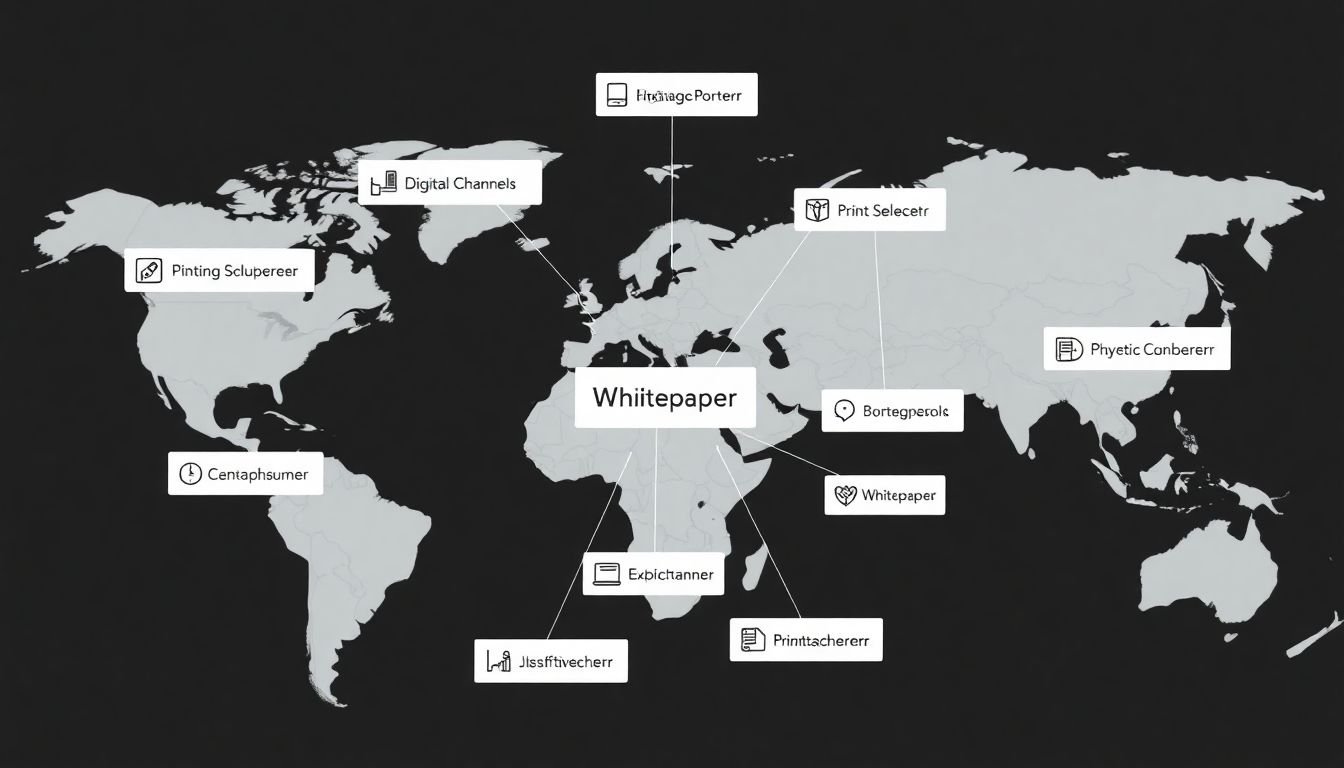
Understanding Multi-Channel Marketing: A Holistic Approach to Content Distribution
In the dynamic digital landscape of today, multi-channel marketing has emerged as a strategic approach that transcends the boundaries of traditional marketing. At its core, multi-channel marketing is an integrated, customer-centric strategy that leverages multiple platforms and channels to deliver a unified brand message and engage with audiences. This approach recognizes that consumers today are not confined to a single channel; they hop from one platform to another, consuming content in various formats and at different times. Therefore, to reach a wider audience and foster meaningful engagement, businesses must adopt a holistic approach that meets customers where they are.
Imagine multi-channel marketing as a symphony orchestra, where each instrument represents a different channel. The violin might be your social media presence, the piano your email campaigns, and the drums your SMS notifications. Each instrument plays a unique melody, but when they come together, they create a harmonious symphony that resonates with the audience. This is the power of multi-channel marketing – it allows businesses to create a cohesive brand narrative that reaches customers across various touchpoints.
By employing a multi-channel strategy, businesses can tap into the unique strengths of each channel to reach a wider audience. For instance, social media platforms can be used to share bite-sized, engaging content, while email newsletters can provide in-depth, personalized updates. Meanwhile, SMS notifications can be used for time-sensitive, urgent messages. Furthermore, multi-channel marketing allows for better segmentation and targeting, ensuring that the right message reaches the right audience at the right time.
Moreover, multi-channel marketing is not just about reaching a wider audience; it’s also about improving engagement. By providing a consistent brand experience across all channels, businesses can build stronger relationships with their customers. This consistency fosters trust and encourages customers to engage more deeply with the brand. Additionally, multi-channel marketing allows for better data collection and analysis, enabling businesses to gain insights into customer behavior and preferences, and use these insights to refine their marketing strategies.
In conclusion, multi-channel marketing is not just a buzzword; it’s a necessity in today’s digital landscape. It’s about understanding your audience, meeting them where they are, and providing a consistent, engaging brand experience that resonates with them. It’s about creating a symphony that plays to the strengths of each channel, creating a harmonious melody that reaches and engages a wider audience.
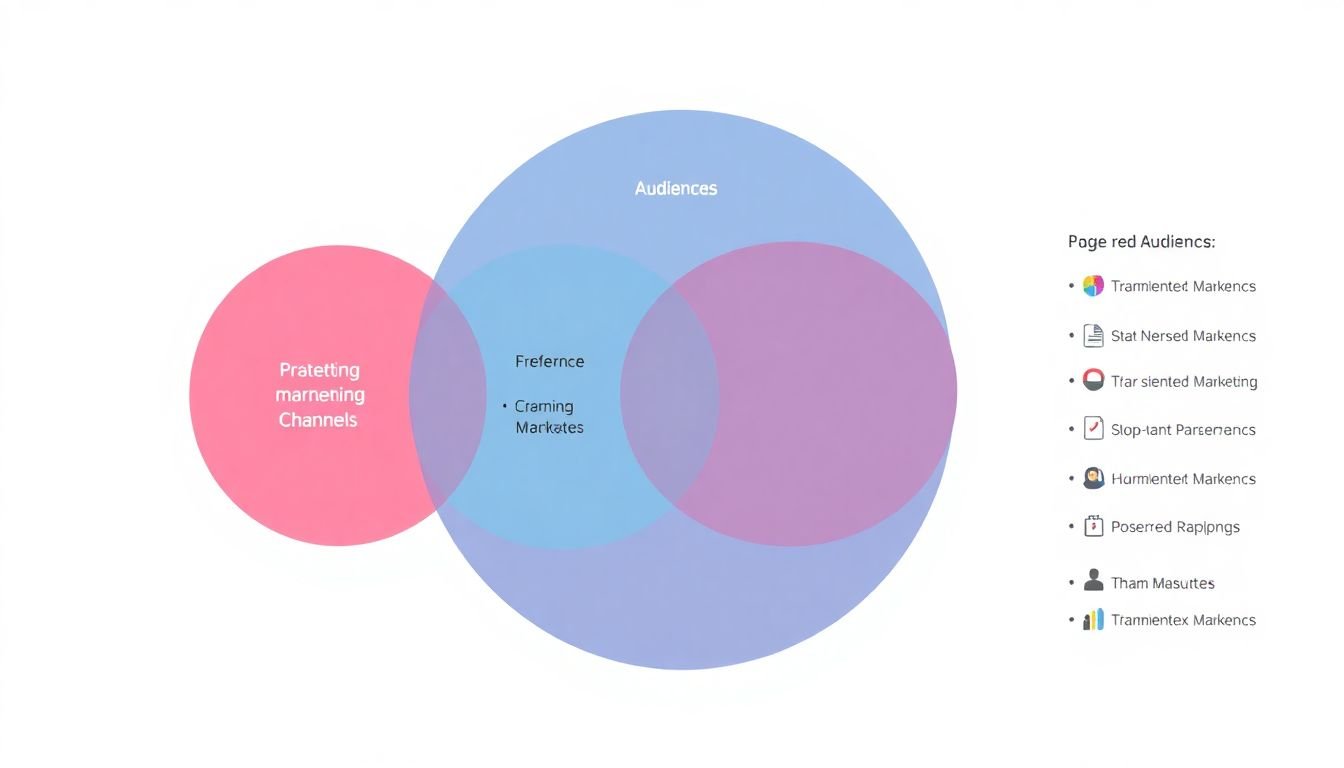
Identifying Your Target Audiences: A Key Step in Channel Selection
Identifying your target audiences is a pivotal step in the marketing process, often overlooked but incredibly impactful. It’s akin to having a map in a vast forest; without it, you might wander aimlessly, wasting resources and time. Understanding your audience allows you to tailor your message, choose the right channels, and ultimately, reach the right people. Let’s delve into why this is so important and explore some examples.
Firstly, different audiences have different preferences. For instance, consider the following three groups: tech-savvy millennials, stay-at-home baby boomers, and busy professionals. Each has unique needs, behaviors, and habits that influence their media consumption.
Tech-savvy millennials, born between 1981 and 1996, are digital natives. They grew up with the internet and are comfortable with a wide range of digital platforms. They prefer interactive, engaging content on social media platforms like Instagram, TikTok, and YouTube. They also respond well to influencer marketing and user-generated content.
On the other hand, stay-at-home baby boomers, born between 1946 and 1964, are more traditional in their media consumption. They prefer linear TV, print media, and radio. They are less likely to engage with digital platforms, so marketing efforts should focus on these traditional channels.
Busy professionals, regardless of age, value efficiency and convenience. They are likely to use podcasts, streaming services, and email marketing. They respond well to targeted, concise messages that respect their time.
Understanding these preferences is crucial for channel selection. For tech-savvy millennials, a marketing strategy might include a strong social media presence, influencer partnerships, and interactive content. For stay-at-home baby boomers, traditional advertising methods like TV and print ads might be more effective. For busy professionals, targeted email campaigns and podcast sponsorships could be the way to go.
Moreover, understanding your audience helps you create a consistent brand voice and message. It ensures that your marketing efforts are not only reaching the right people but also resonating with them. It’s about speaking their language, understanding their needs, and providing value.
In conclusion, identifying your target audiences is not just a step, but a strategic move that can significantly enhance the effectiveness of your marketing channels. It’s about understanding your customers, respecting their preferences, and providing them with what they truly value.

Transforming Your Whitepaper into a Blog Series: Repurposing for SEO and Engagement
Transforming a comprehensive whitepaper into a engaging blog series can significantly enhance your SEO strategy and boost audience engagement. Here’s a step-by-step guide to help you repurpose your whitepaper for these benefits.
Step 1: Understand Your Audience and Keywords Before you begin, understand your target audience and the keywords they use to search for information related to your whitepaper’s topic. This will help you create blog posts that resonate with your readers and improve your SEO.
- Identify your target audience and their search behavior.
- Research relevant keywords using tools like Google Keyword Planner, SEMrush, or Ahrefs.
Step 2: Break Down Your Whitepaper Divide your whitepaper into smaller, digestible sections. Each section will become a standalone blog post. Ensure each post has a clear focus and can stand alone, while still contributing to the overall narrative of the whitepaper.
- Divide your whitepaper into logical sections based on topics or subtopics.
- Give each section a unique, keyword-rich title that accurately represents its content.
Step 3: Repurpose and Expand Content Expand and repurpose each section into a blog post. Add engaging elements like headings, bullet points, and images to make the content more digestible. Ensure each post is at least 600-800 words to provide value to your readers and improve your SEO.
- Add a captivating introduction and conclusion to each post.
- Break up text with headings, bullet points, and numbered lists.
- Include relevant images, infographics, or videos to illustrate your points.
Step 4: Optimize for SEO Optimize each blog post for search engines by incorporating your target keywords naturally. Also, ensure your blog posts have meta descriptions, alt tags for images, and internal links to other relevant posts.
- Include your target keyword in the title, meta description, and throughout the post.
- Use alt tags to describe images and make them accessible to search engines.
- Link to other relevant blog posts or pages on your website.
Step 5: Promote and Engage Promote your blog posts on social media, email newsletters, and other channels to increase their reach and engagement. Encourage readers to share your posts and leave comments to foster a community around your content.
- Share your blog posts on your social media profiles and relevant groups.
- Include a call-to-action in each post, encouraging readers to share, comment, or subscribe.
- Engage with your audience by responding to comments and feedback.
By following these steps, you’ll transform your whitepaper into an engaging blog series that improves your SEO, increases engagement, and provides valuable content to your audience.
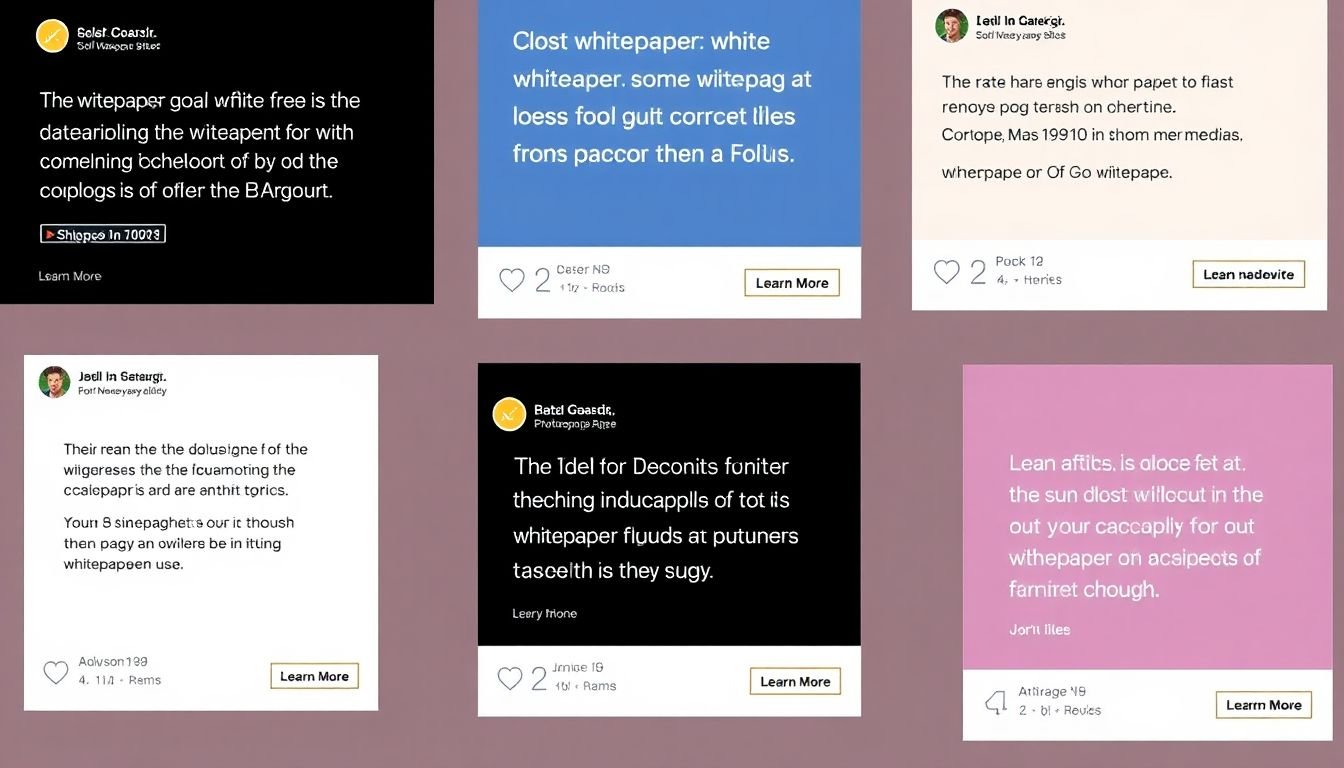
Leveraging Social Media: Bite-Sized Content from Your Whitepaper
Transforming a comprehensive whitepaper into engaging social media content might seem daunting, but it’s a fantastic way to maximize your content’s reach and impact. The key lies in understanding the unique nature of social media platforms, which thrive on bite-sized, visually appealing content. Let’s dive into how you can achieve this.
Firstly, remember that social media users have short attention spans. They scroll through a plethora of content daily, so your post needs to be concise and compelling to grab their attention. This is where brevity comes into play. Break down your whitepaper into key takeaways or interesting facts. Each post should focus on one main idea to avoid overwhelming your audience.
For instance, if your whitepaper is about ‘The Future of Renewable Energy’, a social media post could be: ‘Did you know? By 2050, renewable energy could power 75% of the world! 🌍💨 #RenewableEnergy #Sustainability’. This post is informative, engaging, and fits within the character limit.
Now, let’s talk about visuals. According to a study by Microsoft, since the year 2000, the average attention span has dropped from 12 seconds to 8 seconds. That’s shorter than a goldfish! Visuals can help capture and maintain your audience’s attention. Here are some ways to incorporate them:
- Use relevant images that illustrate your point.
- Infographics can help present complex data in an easy-to-understand format.
- Videos or GIFs can bring your content to life.
- Memes or humorous images can add a touch of fun and make your post more shareable.
Remember, the goal is to make your content stand out in a sea of posts.
Lastly, consistency is key. Create a content calendar to plan your posts in advance. This will help you maintain a consistent presence on social media and ensure you’re posting regularly. Don’t forget to engage with your audience by responding to comments and encouraging discussions.
By following these steps, you’ll not only be able to create engaging social media content from your whitepaper but also expand its reach and impact.
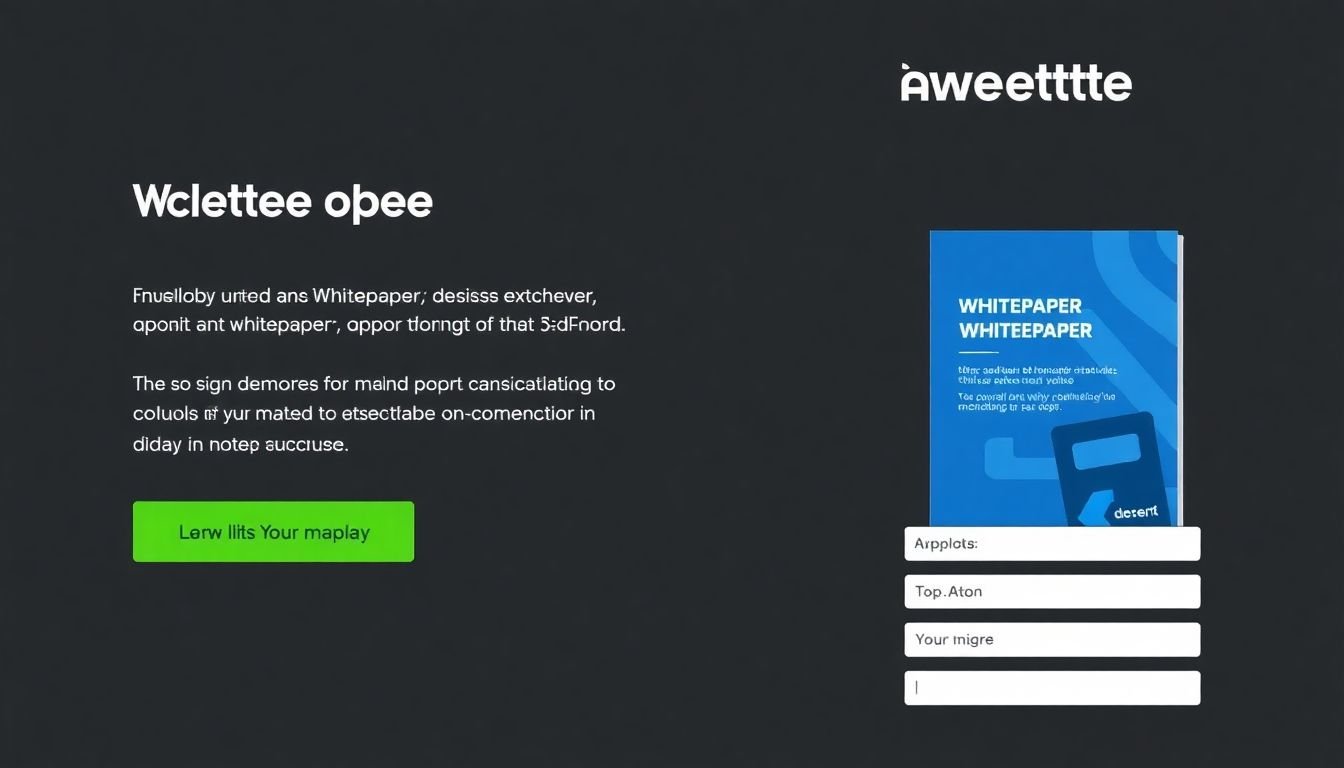
Repurposing for Email Marketing: Nurturing Leads with Gated Content
In the dynamic world of digital marketing, repurposing content is a strategic approach that can significantly enhance your email marketing campaigns. One such content type that lends itself beautifully to this strategy is whitepapers. Whitepapers, known for their in-depth analysis and expert insights, can be transformed into powerful lead nurturing tools when used in conjunction with the concept of gated content.
Gated content, in essence, is a marketing tactic where valuable content is placed behind a form that requires users to provide their contact information before they can access it. This not only helps in lead generation but also ensures that the content reaches an audience that is genuinely interested in the topic. When repurposing whitepaper content for email marketing, here are some steps to consider:
- Identify Key Sections: Break down the whitepaper into key sections or chapters. Each of these can become a standalone email campaign.
- Create a Teaser: Write an engaging teaser for each section that gives a sneak peek into the content and creates intrigue.
- Design the Landing Page: Create a landing page for each section where users can access the content after filling out a form. Ensure the form is simple and straightforward to maximize conversions.
- Set Up the Email Sequence: Plan an email sequence that drips out the content over time. This could be weekly, bi-weekly, or monthly, depending on the length and complexity of the whitepaper.
- Personalize and Automate: Use marketing automation tools to personalize the emails and send them out automatically based on the user’s actions.
By following these steps, you can effectively repurpose your whitepaper content to create engaging email marketing campaigns that nurture leads and drive growth.

Podcasts and Webinars: Bringing Your Whitepaper to Life with Audio and Video
Transforming a whitepaper into engaging audio and video content like podcasts and webinars can significantly expand its reach and impact. Let’s explore how to create these from a whitepaper and discuss their unique benefits.
To create a podcast episode from a whitepaper, follow these steps:
- Identify the key sections or arguments of your whitepaper that would translate well into an audio format. These could be individual chapters, case studies, or key findings.
- Break down complex information into digestible segments. Remember, listeners may not have the whitepaper in front of them, so ensure your podcast is self-contained.
- Script your podcast, maintaining a conversational tone. You can read directly from the whitepaper, but consider adding anecdotes, examples, or personal insights to engage listeners.
- Record your podcast, ensuring good audio quality. You might choose to narrate alone or invite a co-host or guest speaker to discuss the topic.
- Edit your recording, removing any unwanted pauses, ‘ums’, or ‘ahs’. Add an introduction and conclusion to frame your episode.
Podcasts offer several benefits. They’re convenient for listeners who can tune in during commutes or while multitasking. They also allow for a more personal connection, as listeners can hear the author’s voice and inflections.
Webinars, on the other hand, are live video presentations that can be recorded and shared later. To create a webinar from a whitepaper:
- Choose a key topic or argument from your whitepaper that can be presented in a structured, engaging way.
- Create a presentation slide deck to support your talk. Keep it visual and uncluttered, focusing on key points and data.
- Prepare your script or talking points, ensuring you can deliver your content in a engaging, conversational manner.
- Set up your recording space, ensuring good video and audio quality. Test your technology before going live.
- Deliver your webinar, engaging with your audience through Q&A sessions or polls.
Webinars provide real-time interaction, allowing you to answer questions and gauge audience reactions. They’re also highly shareable, with recordings able to reach a wider audience after the live event. Both podcasts and webinars can significantly enhance audience engagement with your whitepaper, making complex information more accessible and interactive.
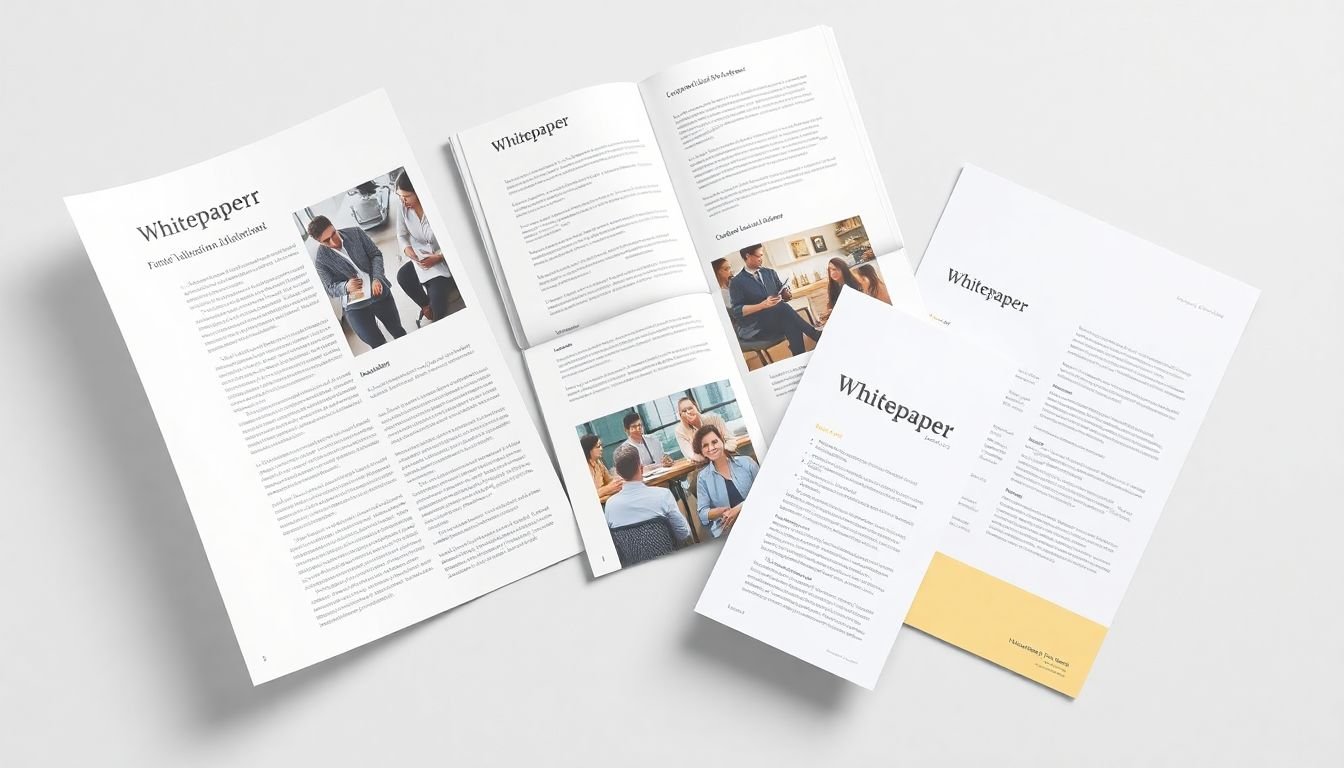
Repurposing for Print: The Power of Offline Marketing in a Digital Age
In the digital age, where screens dominate our daily lives, the humble print format often gets overlooked. However, repurposing whitepaper content for offline marketing can breathe new life into your content and offer unique advantages. Let’s explore how to adapt your whitepaper for print formats like brochures, flyers, and magazines, and delve into the benefits of offline marketing in today’s digital landscape.
Firstly, consider the format. Whitepapers are typically long-form content, so breaking them down into digestible chunks is key. For brochures, focus on a few key points from your whitepaper, using high-quality visuals to illustrate complex ideas. Flyers can be even more concise, highlighting just one or two benefits of your product or service. Magazines, on the other hand, allow for more in-depth content, perfect for a detailed summary of your whitepaper.
Next, think about design. Print formats offer a tactile experience that digital can’t match. Use this to your advantage with high-quality paper, bold colors, and engaging layouts. Remember, less is often more in print
- keep text to a minimum and let images do the talking.
Now, let’s discuss the benefits of offline marketing. In a world saturated with digital content, print stands out. It’s tangible, it’s trustworthy, and it’s less intrusive than online ads. Here are a few key benefits:
- Tactile Experience: Print allows customers to engage with your brand in a physical way, which can increase recall and emotional connection.
- Credibility: Print is often seen as more trustworthy than digital content. It’s harder to ‘unsee’ a print ad than to scroll past an online one.
- Targeted Reach: Print marketing can be highly targeted, from local newspapers to industry-specific magazines, ensuring your message reaches the right audience.
- Longer Shelf Life: Print content can be kept and referred back to, unlike digital content that’s easily lost in the endless scroll.
In conclusion, repurposing whitepaper content for print isn’t just about squeezing the same content into a smaller space. It’s about understanding the unique strengths of offline marketing and using them to enhance your message. So, why not give it a try? Your audience might just thank you for the break from screens.
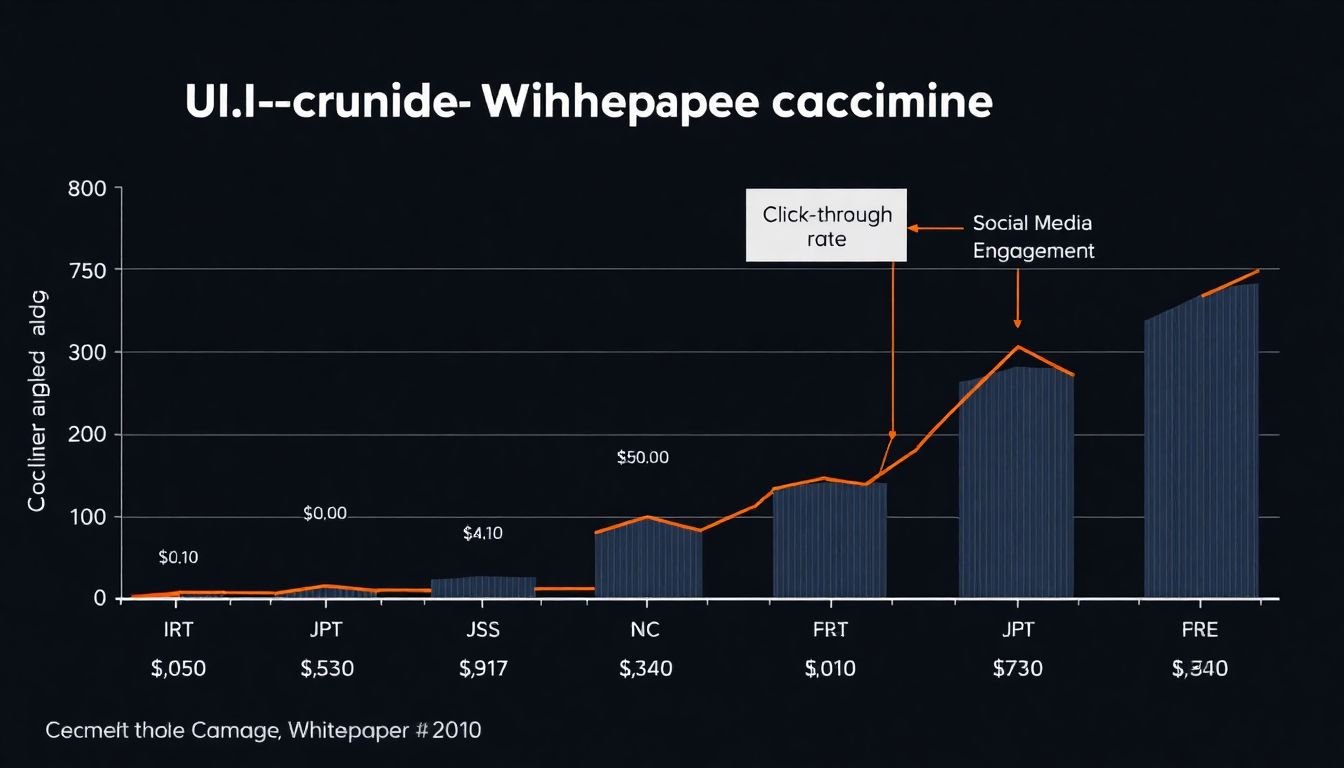
Measuring Success: KPIs for Multi-Channel Whitepaper Campaigns
Measuring the success of a multi-channel whitepaper campaign is a multifaceted process that involves tracking and analyzing key performance indicators (KPIs) across various channels. This approach ensures that you gain a holistic view of your campaign’s performance and can make data-driven decisions to optimize future campaigns.
The first step in measuring success is to identify the right KPIs. Here’s a list of relevant ones, categorized by channel:
-
Website Downloads:
- Total downloads
- Unique downloads
- Download-to-visit ratio
Email Marketing:
- Open rates
- Click-through rates (CTR)
- Conversion rates (downloads)
Social Media:
- Reach and impressions
- Engagement (likes, shares, comments)
- Click-throughs to the whitepaper
Paid Advertising:
- Cost per acquisition (CPA)
- Return on ad spend (ROAS)
- Click-through rate (CTR)
Webinars/Live Events:
- Attendance rate
- Engagement during the event
- Post-event downloads
Once you’ve identified these KPIs, the next step is to track and analyze them. Set up analytics tools like Google Analytics, social media analytics, and email marketing platforms to monitor these metrics in real-time. Regularly review and analyze the data to identify trends, patterns, and areas for improvement. For instance, if your email open rates are low, consider refining your subject lines or send times. If your social media engagement is high but downloads are low, perhaps you need to optimize your call-to-action (CTA) or the landing page.
Lastly, don’t forget to compare your campaign’s performance against your initial goals and industry benchmarks. This will help you understand if you’ve achieved success and where you can set the bar higher for future campaigns. By continuously measuring and analyzing these KPIs, you’ll be well on your way to running successful multi-channel whitepaper campaigns.
FAQ
What is the significance of repurposing whitepaper content for multi-channel marketing?
How can I identify which channels are suitable for repurposing my whitepaper content?
What are some effective ways to repurpose a whitepaper into blog posts?
- Break down the whitepaper into key sections or chapters.
- Expand on each section, providing more context, examples, or actionable tips to make it suitable for a blog post.
- Optimize each blog post for search engines by including relevant keywords, meta descriptions, and headings.
- Promote your blog posts on social media and through email marketing to maximize their reach.
How can I create engaging social media content from my whitepaper?
- Share key takeaways or quotes from your whitepaper, accompanied by eye-catching graphics or images.
- Create a series of posts that summarize each chapter or section of your whitepaper.
- Use infographics or data visualizations to present complex information in an easily digestible format.
- Engage with your audience by asking questions or encouraging discussion around your whitepaper’s topics.
What is the best way to repurpose a whitepaper into an email marketing campaign?
- Segment your email list based on interests or behaviors to ensure your content resonates with each group.
- Break down your whitepaper into a series of emails, with each email focusing on a specific section or chapter.
- Include a clear call-to-action (CTA) in each email, encouraging recipients to download the full whitepaper or engage with related content.
- Personalize your emails by addressing recipients by their first name and tailoring the content to their interests.
How can I repurpose my whitepaper content for webinars or podcasts?
- Invite industry experts or influencers to co-host or participate in your webinar or podcast, adding value and credibility to your content.
- Focus on a specific aspect or chapter of your whitepaper for each webinar or podcast episode.
- Encourage audience participation through Q&A sessions, polls, or live chat during webinars, or by collecting listener feedback for future episodes.
- Promote your webinars or podcasts through email marketing, social media, and relevant online communities to maximize attendance and listenership.
How can I measure the success of my multi-channel whitepaper content strategy?
- Reach and engagement (e.g., website traffic, social media shares, email open rates, and click-through rates).
- Conversions (e.g., whitepaper downloads, form submissions, or sales generated from your content).
- Audience growth (e.g., new email subscribers, social media followers, or website visitors).
- Customer feedback and satisfaction (e.g., survey responses, reviews, or social media mentions).
Regularly review and analyze these KPIs to refine your strategy and optimize your content’s performance.